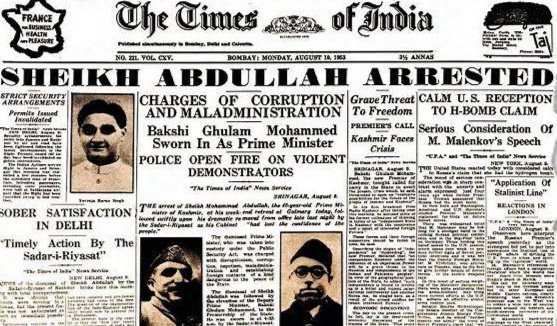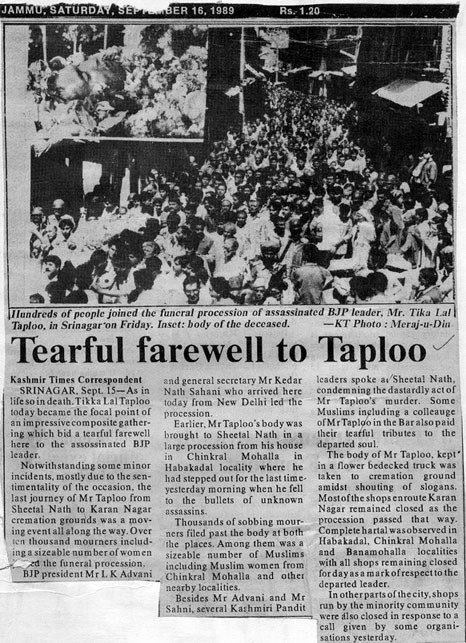
Today, Pakistan and China are at odds with India over strategic territory in the icy Himalayas. At stake is not only Kashmir but also the neighboring regions of Jammu and Ladakh. This conflict, which raises the specter of nuclear war, goes back centuries.
As the Mughal Empire crumbles, the Afghans and Sikhs fight over the crumbs. A Sikh army wins the Battle of Shopian and takes over Kashmir.
Zorawar Singh Kahluria, the Dogra general of the Sikh Empire, leads audacious campaigns in high altitudes to conquer Buddhist Ladakh and Shia Baltistan.
Kahluria ends up with a lance in his chest in his attempt to conquer western Tibet. The Sikh Empire now controls a swathe of territory — which includes modern-day Jammu, Kashmir, Baltistan and Ladakh — currently contested between India, Pakistan and China.
Gulab Singh Jamwal, the Dogra general of a fast-tottering Sikh Empire, strikes out on his own with British blessings. The lands of Jammu, Kashmir, Baltistan and Ladakh that the Sikhs ceded to the British are now sold to Jamwal for 7.5 million Nanakshahi rupees. The kingdom of Jammu and Kashmir goes on to become one of the 584 princely states of British India.
As the Gangetic plains erupt in revolt, the Dogras stay loyal to the British. Not only do Kashmir's rulers give refuge to British women and children, they also send troops who help win back Delhi from Indian mutineers. The British reward them for their loyalty and increase their gun salute from 19 to 21.
Hari Singh, the former pageboy of Lord Curzon, ascends the throne. Weak, profligate and dissolute, he becomes known more for a scandal involving a Parisian prostitute than any achievement in war or peace.
Molvi Abdullah, a polymath and lawyer, leads a public agitation for liberty, justice and democracy. He stirs Kashmiri youth to rise up against the effete king. The king appoints a grievances commission with experienced colonial administrator Sir Bertrand James Glancy as president.
Mohammed Abdullah Sheikh, better known as Sheikh Abdullah, along with Chaudhry Ghulam Abbas and Molvi Abdul Rahim, the son of Molvi Abdullah, starts the All Jammu and Kashmir Muslim Conference. It is the first political party in the kingdom and aims to contest elections for the new legislative assembly that Glancy recommends the king set up.
Praja Sabha, the new legislative assembly, is formed. Women do not have the vote. Neither do illiterate men without sufficient property, title or annual income. Scholars estimate 3–10% of the population has the vote. The king retains all the power.
Sheikh Abdullah meets Jawaharlal Nehru and they become close friends. They both demand similar rights for their people from the British rulers and their stooges. Nehru supports the people of princely states in their struggle for a representative government.
After a prolonged and vigorous campaign, 172 out of 176 members vote in a special session of the Muslim Conference to change its name to the National Conference. From now on, the party is open to all religions. Reportedly, Abdullah is inspired by Nehru to make this change in his party.
Not everyone agrees with Sheikh Abdullah. His former comrade-in-arms Chaudhry Ghulam Abbas revives the Muslim Conference. It soon becomes client to Muhammad Ali Jinnah's All-India Muslim League, which wants to create Pakistan.
Sheikh Abdullah launches the Quit Kashmir agitation against Hari Singh. He is arrested and is sentenced to three years' imprisonment.
As British India heads for partition, the Muslim Conference leads a revolt against Hari Singh in Poonch. Riots break out. Muslims kill Hindus and Sikhs. Singh's forces massacre Muslims in retaliation. The violence unleashed by the partition reaches Kashmir.
Even as Hari Singh dreams of ruling independently, Pakistan sees Muslim-majority Kashmir as a natural part of its territory. Chaudhry Ghulam Abbas appeals for help and Pakistan sends Pashtun tribesmen to take over. Singh panics and signs the Instrument of Accession on October 26. Indian soldiers land in Srinagar and the first India-Pakistan war begins.
As Indian troops push back Pashtuns and Pakistani troops, Jawaharlal Nehru, who has taken over as India’s first prime minister, approaches the newly formed United Nations Security Council on January 1. He pulls troops back, ceding land to Pakistan. The Line of Control (LoC) becomes the de facto border between the two countries.
In a historic resolution, the United Nations Security Council calls for a plebiscite in Jammu and Kashmir. Pakistan is to withdraw its troops, and India is to reduce its forces “to the minimum strength,” only for the “maintenance of law and order.” Both parties ignore the resolution.
Azad Kashmir, the part of Kashmir controlled by Pakistan, signs the Karachi Agreement with Islamabad, ceding control over defense and foreign affairs. Islamabad also assumes direct control of Gilgit-Baltistan. The agreement would remain a secret until the 1990s.
Hari Singh releases Sheikh Abdullah and loses power. Abdullah and other delegates from the National Conference join the Constituent Assembly of India.
The Constituent Assembly of India adopts Article 370 of the Indian Constitution, an interim measure giving special status and autonomy to Jammu and Kashmir. New Delhi's jurisdiction is limited to just three areas: defense, foreign affairs and communications.
China invades Tibet on October 7. From now on, the People's Republic of China (PRC) has an extended border with India. The Ladakh region of Jammu and Kashmir now borders not independent Tibet but the communist PRC.
Elections are held for the Constituent Assembly of Jammu and Kashmir, with 75 seats allocated to the India-administered part of Kashmir and 25 seats reserved for the Pakistan-administered part. Sheikh Abdullah's National Conference wins all 75 seats and drafts a new constitution.
Sheikh Abdullah and Jawaharlal Nehru conclude the Delhi Agreement. Jammu and Kashmir gets autonomy. It promises its regions, like Jammu and Ladakh, autonomy as well.
Syama Prasad Mukherjee enters Jammu and Kashmir. He is the leader of Bharatiya Jan Sangh, the forerunner of the Bharatiya Janata Party (BJP), and opposes Article 370. Sheikh Abdullah arrests Mukherjee, who dies under suspicious circumstances. Popular unrest breaks out, but Nehru refuses to order an inquiry.
Also in May, American statesman Adlai Stevenson arrives in India as part of his world tour. This former Democrat presidential candidate meets Sheikh Abdullah twice, and Indians suspect him of instigating Kashmiri independence. Reportedly, the US is to give Kashmir a loan of $15 million, boost the Kashmiri economy and electrify all villages within three years.
Rumors break out that Sheikh Abdullah is swayed by visions of being the big boss of the "Switzerland of the Himalayas." He allegedly plans to declare independence on August 21, coinciding with the Muslim holiday, Eid. Jawaharlal Nehru arrests Abdullah and puts Bakshi Ghulam Mohammed in charge.

A presidential order under Article 370 gives Jammu and Kashmir the right to define permanent residents. The government now decides who can vote, contest elections, own property, buy land, get government employment or gain any other benefits in the state. The order becomes Article 35A and is met with resentment because no other Indian state has such privileges.
After the Tibetan uprising, the Dalai Lama flees to India and China formally annexes Tibet. A few years earlier, China had taken over Aksai Chin, a part of Ladakh that India claimed. India–China tensions rise.
India and Pakistan sign the Indus Water Treaty to divide usage of the six rivers in the Indus basin. India takes control of the three eastern rivers that contribute 20% of the flow of the basin. Pakistan takes control of the western ones, securing its water supply. This treaty stands the test of time despite India and Pakistan engaging in many military conflicts.
China routs India in a brief war, humiliating Jawaharlal Nehru and Krishna Menon, his arrogant and incompetent defense minister. Menon falls on his sword and resigns. Nehru stays on. China establishes complete control of Aksai Chin.
Pakistan and China sign a border agreement, swapping land in the Shaksgam Valley with each other. It is the first agreement China signs with a non-communist country. As an American ally, Pakistan is taking a bold step with this agreement. By swapping land, it wins Chinese recognition that India does not have sole right to the erstwhile princely state of Jammu and Kashmir.
Kashmiris believe that Moi-e-Muqqadas, a strand of the beard of Muhammad — the founder of Islam — is preserved at the Hazratbal Shrine. This went missing on December 27, triggering riots and ethnic cleansing of Hindus in East Pakistan, modern day Bangladesh. Hundreds of thousands of them flee to India.
After many years, Sheikh Abdullah is released from prison. He is acquitted of the charge of sedition and receives a rapturous welcome from the Muslim population of the state of Jammu and Kashmir.
Pakistan takes advantage of discontent in Kashmir and sends armed infiltrators over the border. India retaliates by invading Punjab. A full-scale war breaks out. During the ensuing peace negotiations in Tashkent, Indian Prime Minister Lal Bahadur Shastri dies mysteriously.
India and Pakistan fight yet another war. India defeats Pakistan decisively, liberating East Pakistan, where Islamabad has been following a brutal policy of violence, repression and rape. Bangladesh is born as a new country, with 66 million mostly Muslim citizens. This damages Pakistan's claim to represent South Asia's Muslims.
India and Pakistan sign the Shimla Agreement. India returns over 90,000 prisoners of war, and Pakistan agrees that the Kashmir dispute is a bilateral issue with no room for intervention from third parties, including the United Nations. Pakistan goes on to violate this agreement repeatedly. India snatches defeat from the jaws of victory because Zulfikar Ali Bhutto outfoxes Indira Gandhi.
Sheikh Abdullah returns from the wilderness to sign an accord with Indira Gandhi, the daughter of Jawaharlal Nehru and successor of Lal Bahadur Shastri. After two decades in the political wilderness, of which many are spent in prison, Abdullah becomes chief minister of Jammu and Kashmir.
Sheikh Abdullah dies. In South Asian tradition, his son Farooq Abdullah becomes the new leader of the party and the chief minister of the state.

Indian troops take control of Siachen Glacier and the heights of Saltoro Ridge, preempting Pakistani movements by just one day. India wins 3,000 square kilometers of territory. Troops of both countries stand eyeball to eyeball to this day, making this the world's highest battlefield. The harsh conditions of the glacier, where temperatures fall as low as -50°C, are far more deadly than the fighting between Indian and Pakistani troops.
Farooq Abdullah wins elections to become chief minister again. Many maintain that Rajiv Gandhi, the son of Indira Gandhi, rigged the elections. Sir Mark Tully, a legendary BBC journalist, calls it “a hopelessly clumsy, cack-handed operation.” The people of Kashmir lose faith in the ballot box.
Islamic militant groups start a full-blown insurgency in Kashmir. The Jammu Kashmir Liberation Front (JKLF) leads this effort. Their goals include establishing Sharia law, Islamizing Kashmiri society and merging with Pakistan. The ethnic cleansing of Kashmiri Hindus begins with the assassination of Tika Lal Taploo, a local BJP leader. India begins large-scale military deployments across Kashmir.

Hizbul Mujahideen, a jihadi organization that wants Kashmir to merge with Pakistan, presents minority Hindu Pandits with three choices — “ralive, tsaliv ya galive” (“convert to Islam, leave the place or be ready to perish”). Almost 600,000 Kashmiri Pandits are forced to flee. Local Muslim strongmen take over their property and destroy their temples. In 1995, India's National Human Rights Commission concludes this ethnic cleansing to be “akin to genocide.”

Indian security forces and the JKLF get into a firefight. After 11 people die, the JKLF militants barricade themselves inside the Hazratbal Shrine. After a three-day standoff, the police allow them to leave. Three days after the militants leave, Indian soldiers demolish JKLF's headquarters using mortar fire. They kill 22 people, including a JKLF leader, Shabir Siddiqui.
Around 50 men storm the tiny village of Wandhama where they line up 23 Kashmiri Pandits and shoot them dead. The Indian government blames Lashkar-e-Taiba, a Pakistan-based Islamist group, for the killings.
After nearly a decade of anti-insurgency operations, the Indian Army broadens its focus to infrastructure development and schemes for public welfare.
Pakistani troops led by General Pervez Musharraf occupy positions across the LoC that the Indians vacated during the winter. This incursion occurs in the strategically important Kargil area, located on the highway connecting Leh and Srinagar. The Indian Army fights intense high-altitude warfare to recover lost ground. The risk of nuclear war recedes when the US gets Pakistan and India to agree to localizing the conflict. Pakistan eventually retreats.
Five Pakistani terrorists hijack an Indian Airlines Flight 814 (IC 814) with 180 people on board from Kathmandu in Nepal and land it first at Amritsar in India. After flying to various locations, IC 814 finally lands at Kandahar in Taliban-ruled Afghanistan. The Indian government capitulates and releases Maulana Masood Azhar, Ahmed Omar Saeed Sheikh and Mushtaq Ahmed Zargar. Azhar goes on to found Jaish-e-Muhammed in 2000, which attacks the Indian Parliament in 2001 and Mumbai in 2008. Sheikh murders American journalist Daniel Pearl and Zargar still trains Islamic jihadis to fight India.
After the tragic September 11 al-Qaeda attacks, the US invades Afghanistan. Over time, the US-led intervention ties up jihadis and their Pakistani sponsors in Afghanistan, leading to lesser cross-border jihadi infiltration into Kashmir and some respite for Indian troops.
Omar Abdullah, the son of Farooq Abdullah, wins the elections, becoming the youngest chief minister of the state. The 38-year-old scion has little legitimacy because the All Parties Hurriyat Conference, the main Kashmiri separatist group, has called on the people to boycott elections. Separatist protests break out and security forces struggle to control them.
Mass protests break out again. Initially, protesters demand independence from India after security forces kill three young men. Then, crowds denounce the US because they are outraged by the plans of a Florida pastor to burn the Quran. From now on, many protests take a pan-Islamist flavor.
Mufti Mohammad Sayeed, the former home minister, wins the December elections and becomes chief minister in 2015. When he dies a year later, his daughter Mehbooba Mufti succeeds him as leader in yet another dynastic Kashmiri succession. The Sayeeds take the support of the BJP to win power.
Indian security forces kill Burhan Muzaffar Wani, a poster boy of the Kashmiri insurgency. The killing triggers the worst violence in the state since 2010. A curfew is extended to 53 consecutive days, and the lockdown continues for eight months.
Mehbooba Mufti's alliance with the BJP collapses. New Delhi imposes direct rule on Jammu and Kashmir. Mufti shifts her support to Islamist groups despite the fact that one such outfit had kidnapped her sister, Rubaiya Sayeed, in 1989.
A suicide attack in Pulwama kills 40 Indian paramilitary troops. Pakistan-based terrorist group Jaish-e-Mohammed claims responsibility. India responds with airstrikes on Balakot, deep inside Pakistani territory. Pakistani fighter jets enter Indian airspace to retaliate. Pakistan captures an Indian pilot after shooting down his plane, but releases him shortly afterward.
After Narendra Modi wins a second term with a thumping parliamentary majority, India revokes Article 370. Jammu and Kashmir loses its special status. The state is divided into two union territories directly administered by New Delhi: Ladakh, and Jammu and Kashmir. Pakistan and many international news outlets cry foul. A majority in India celebrates as the BJP achieves the dream of its founder Syama Prasad Mukherjee, who died opposing Article 370 in 1953.
Elections to the District Developmental Council are held in Jammu and Kashmir. In this new union territory, 51.5% of eligible voters turn up to cast their votes.
India hosts the third G20 Tourism Working Group meeting in Srinagar. Despite mixed reception from Western media, this demonstrates improved safety, peace and economic development in the region. Delegates of China, Turkey, Saudi Arabia and Egypt boycott this meeting even as economic and political turmoil afflicts in Pakistan-controlled Gilgit-Baltistan and Azad Kashmir.
The Supreme Court of India rules that the revocation of Article 370 was constitutional. Petitioners argue that the move violated Jammu and Kashmir's state sovereignty. Chief Justice Dhananjaya Yeshwant Chandrachud rejects the argument, ruling that “Jammu and Kashmir does not have internal sovereignty different from other states.” The court adds that the government should hold elections in the region by September 2024, as well as restore Jammu and Kashmir's statehood “at the earliest.”
Credits Researched
by Ayan
Rakshit, Ansh
Joshi and Deepak
Dhariwal
Supervised by Atul Singh and Ishtiaq
Ahmed
Edited by Anton Schauble and
Lee
Thompson-Kolar
Produced by Lokendra Singh
Images courtesy
of Shutterstock and Creative Commons

